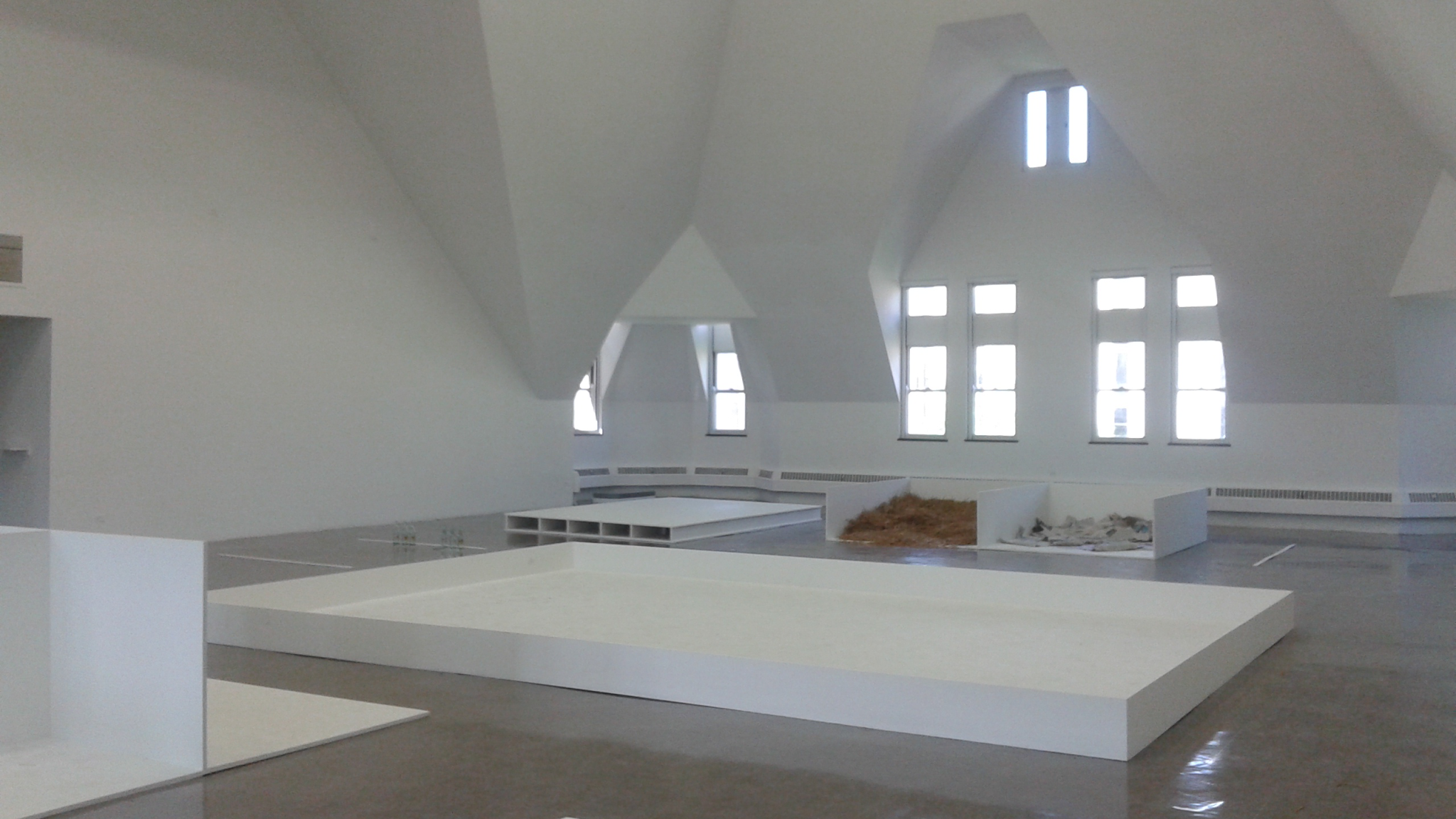Entering Gabriel Sierra’s new site-specific exhibition at the Renaissance Society, my attention was not pulled toward Sierra’s work itself, but rather to the negative space surrounding it—the vastness of the gallery, and its shades of white and blue. With little exception, the entire room, Sierra’s pieces included, is white and angular. The exhibition, however, asks the viewer to do more than just contemplate the space: to help navigate his exhibition, the first U.S. solo show for the Bogotá, Colombia-based artist, Sierra has left viewers with instructions, albeit vague ones, on how to interact with his constructions.
The installation consists of fourteen separate structures, designated as “areas,” in which to engage with others or with the space itself. If this sounds intimidating, fear not—each of these spaces and constructions is complete with guidelines on how to approach the space, conceptually and physically, in relation to space and time. Plan to walk, touch, talk, jump, and stand—a lot.
Despite some instruction, a lot is still left up to the viewers’ individual experience and their willingness to consider Sierra’s work. His treatments of temporality and man-made objects, which seem organized and deliberate, are also ambiguous and enigmatic, and at times difficult to grasp; the exhibit might leave an individual vaguely gazing around, wondering what they should be doing next.
To complicate matters further, the title of the installation changes eight times a day, on the hour. Anna Searle Jones, Director of Communications at the Renaissance Society, said she watches viewers contemplate Sierra’s work all day as they “work” to understand and enjoy the space. Despite how difficult this “work” might sound, the feedback has been largely positive.
“A number of people have mentioned to us that they don’t normally like exhibitions where you have to ‘do’ something, but that they really got into trying out his instructions,” Jones said. “I think that there is a certain humor to them that makes them a bit more palatable.”
As Sierra told a small audience at his artist’s talk during the week of the installation opening, construction doesn’t always mean building objects; one can construct ideas, creating powerful attitudes. Sierra’s exhibit is best described as just that: an attitude.
Sierra hopes that by changing titles, which he considers the most significant component of his pieces, he will alter the relation viewers have with the gallery and their perception of its space, producing interactions and emotions based on the logic governed by the title.
These titles, ranging from “An Actual Location for this Moment” (3pm), to “Few Will Leave Their Place to Come Here for Some Minutes” (4pm), are poetic and compelling, perhaps affecting the “attitude” more than the physical aspect of the installation. Jones said that these lines have made her more attuned to how the space changes with regard to light.
In his artist’s talk, Sierra emphasized that each of the installation’s interactive areas is not a visitor’s destination, but more so a passage within the space, representative of traversing through experiences, or what he considers “momentary neutral zones.” This idea begins before a visitor even steps through the door, since Sierra has lined the entrance with white strips. This interest in space can perhaps be traced to his training in architecture and design, though he also draws on Latin American Modernism.
As I make my way through the space, whitewashed and filled with natural sunlight, no pathway feels empty. The constructions themselves as well as the negative space between them are thoughtful, precise, and, whether intentionally or not, calming. Sierra has paid careful attention to the way in which viewers will walk, pause, interact, and breathe within his space. As he noted at his talk, his project wishes to address what happens between rooms, in the act of crossing from one room to another, especially as he takes away the common labels or functions of rooms (such as the kitchen or living room). “What happens when you walk from one empty room to another empty room?” Sierra asked.
In exploring the exhibit, I quietly jumped, carefully lifted, and more so than anything, spun around, taking in the shapes and lines constructed around me. After spending some time in the space, I was more willing to attempt his guidelines, portrayed with stick figures in a handy pamphlet at the door. I made more noise, lifted my feet higher, took more pictures and less heed, allowing myself to become more comfortable with my surroundings. Easy enough, since the gallery was quiet the particular morning and particular hour (10:30am) I visited. At that time, the exhibition was called “Monday Impressions.”
Sierra seems to envision exactly what he wants to see, and what he wants his visitors to feel, in this exhibition. As the Renaissance Society enters its centennial celebration, Sierra’s avant-garde ideas fit well with its goal to go beyond the traditional notion of a gallery.
“He really considered the gallery here at the Ren in terms of the size and forms of the constructions,” Jones said. “The works in this show were built specifically for the Ren and will be dismantled after the exhibition closes.”
Sierra’s work is mirrored beautifully in the Renaissance Society’s architecture, breathing life into a space that has embraced him with welcoming arms. The two together have constructed not only pieces of an exhibition, but also an attitude: impermanent, aesthetically thoughtful, and intriguing.

